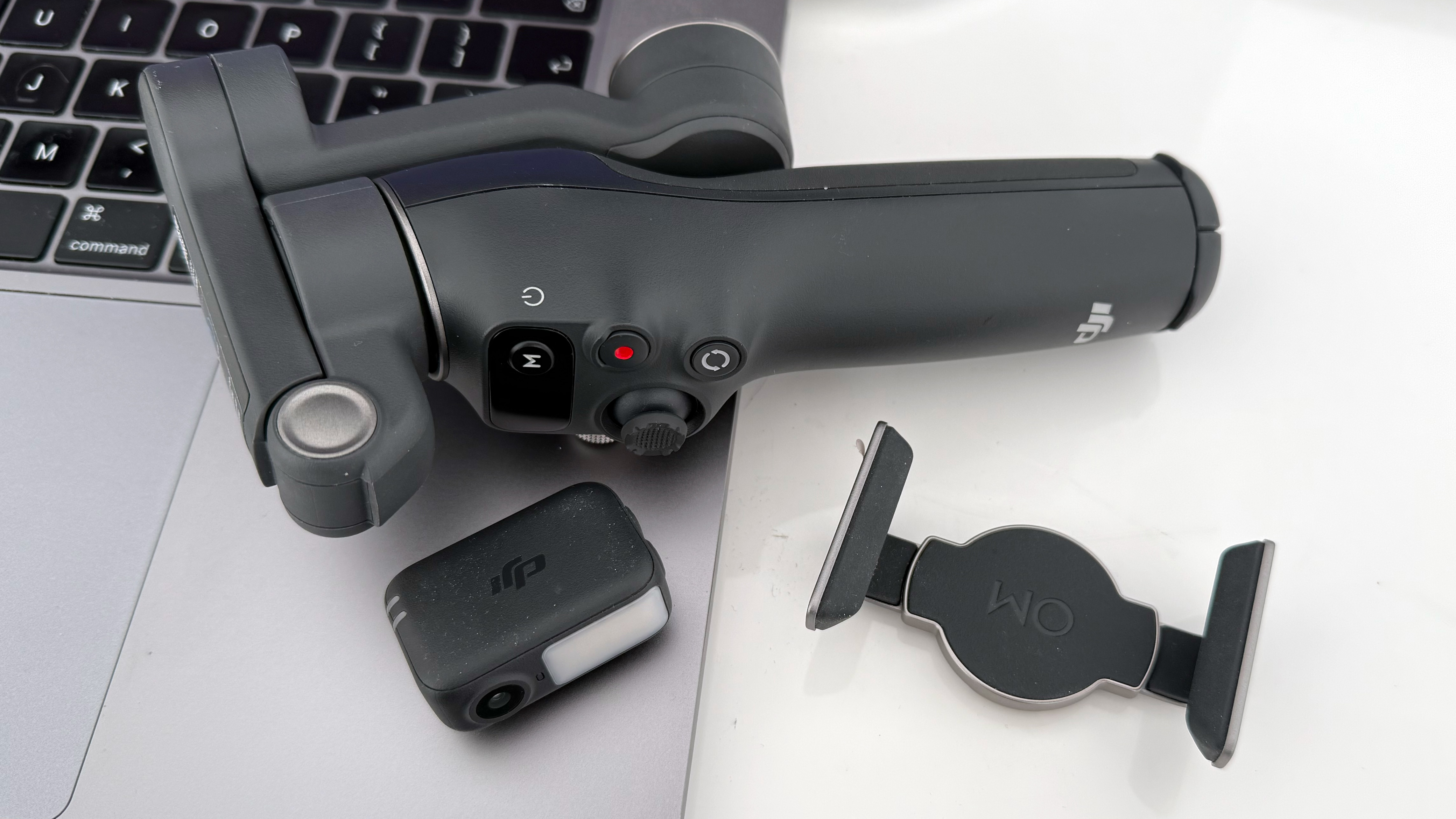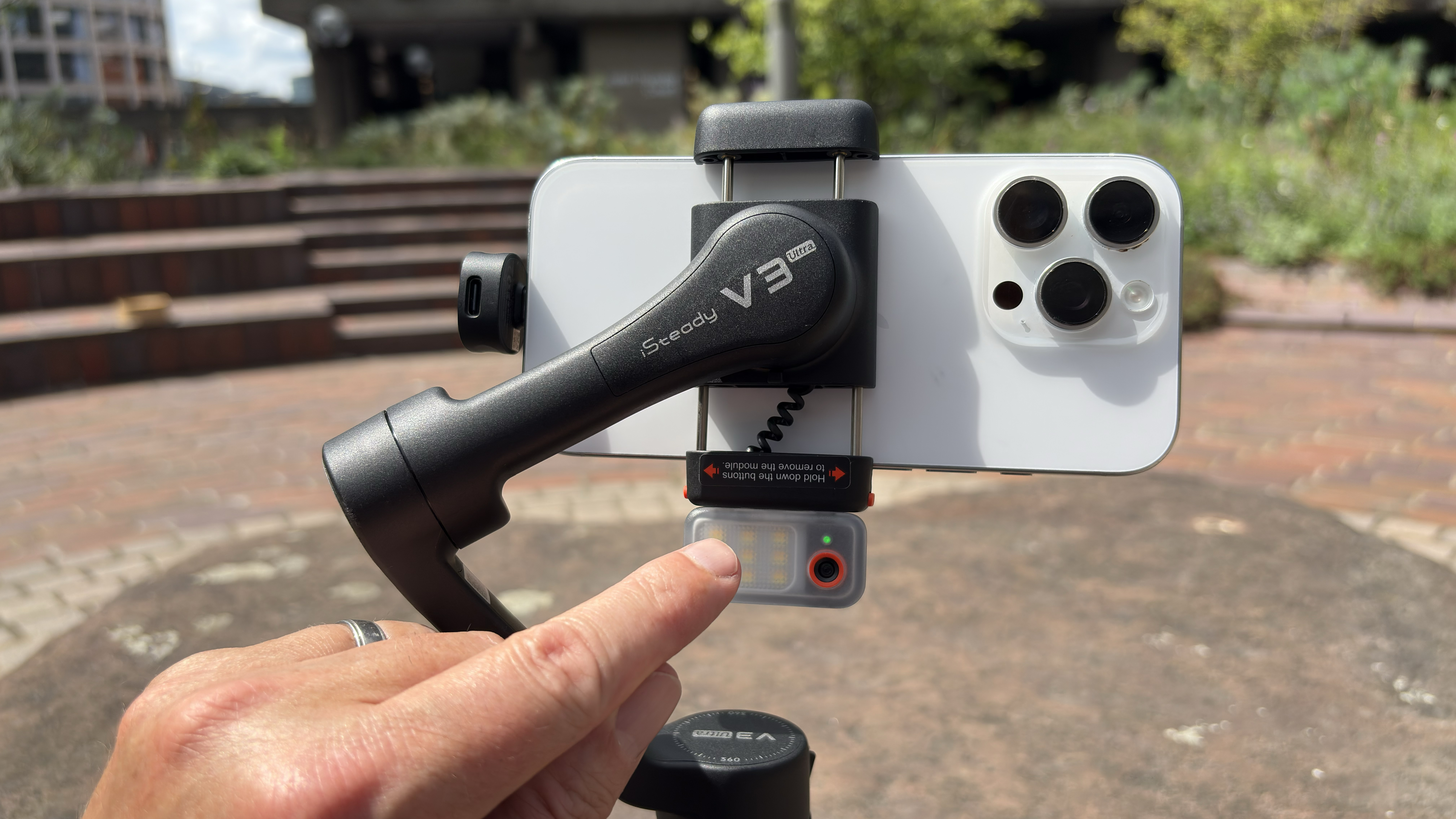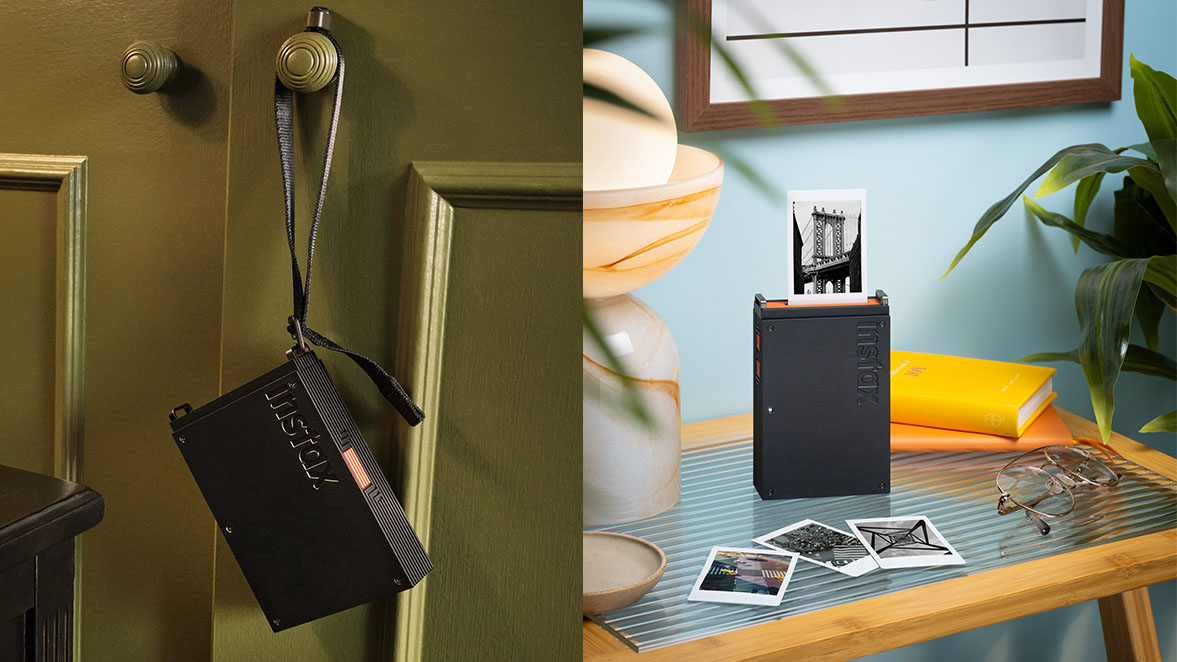The best smartphone gimbals for iPhones and Android phones: make your phone footage silky smooth
Transform your phone into a cinematic filmmaking tool, with the best smartphone gimbals

The best smartphone gimbals make it trivially easy to shoot super-smooth video. Even the best stabilization systems can't fully ward off the effects of a shaky hand, and with a dedicated gimbal, you can effortlessly create smooth panning and sweeping motions in your footage. Many modern gimbals also boast smart features that allow them to track subjects in the frame, making them perfect for to-camera presenting.
In this guide, I've compiled the best smartphone gimbals available today, based on the DCW team's reviews and my own experience. These mechanical stabilizers use multiple axes of rotation (usually three) to steady your smartphone, with independently working motors compensating for movement in all directions.
Furthermore, the best smartphone gimbals come equipped with companion apps that wirelessly integrate in order to offer advanced features like subject tracking, automated panoramas, and more. If you're using a dedicated camera rather than a smartphone, be sure to check out our separate guides for the best gimbals for DSLR and mirrorless cameras, as well as best GoPro gimbal.

Gareth is a photographer based in London, working as a freelance photographer and videographer for the past several years, having the privilege to shoot for some household names. With work focusing on fashion, portrait and lifestyle content creation, he has developed a range of skills covering everything from editorial shoots to social media videos – for which he has made use of the best smartphone gimbals.
The Quick List
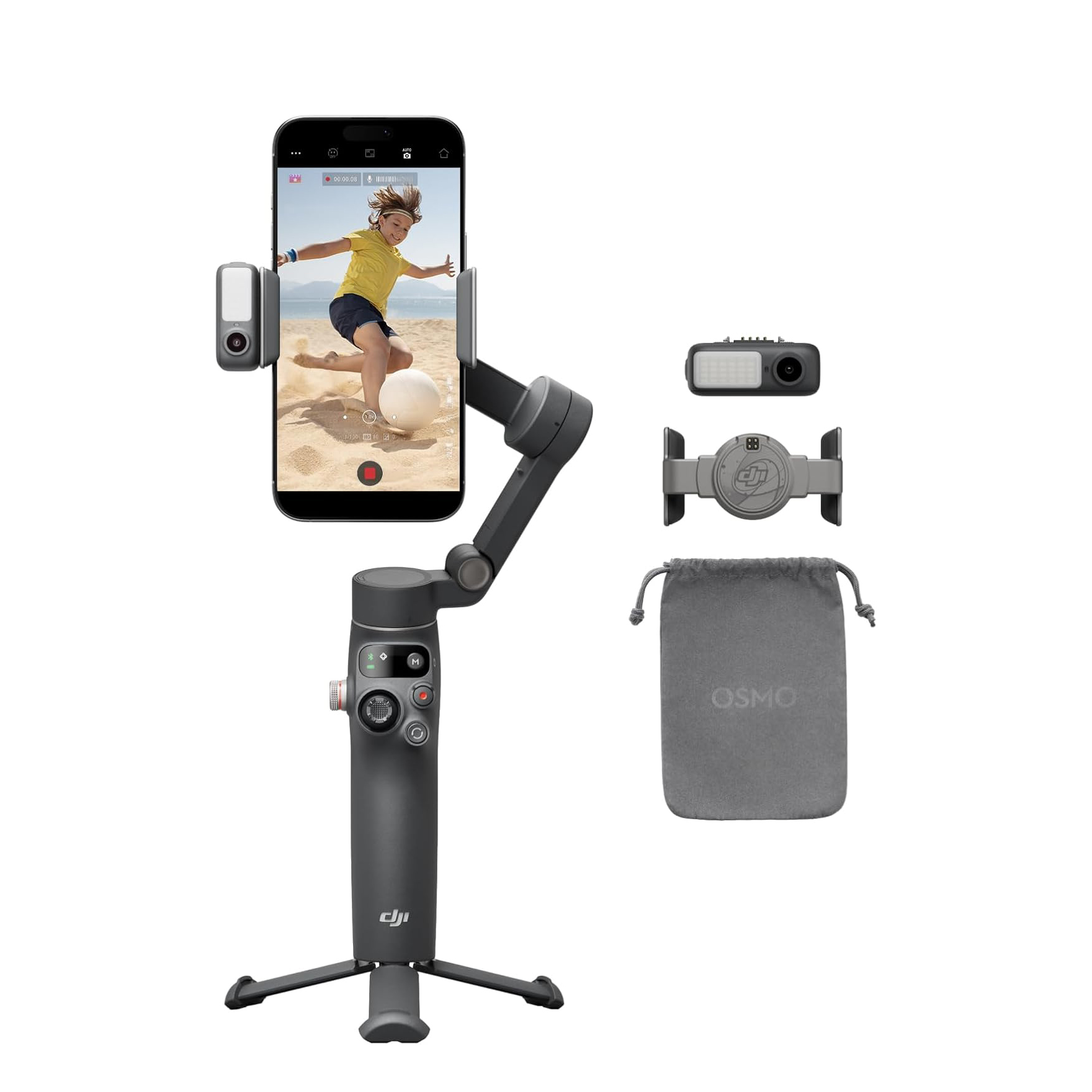
We'll start with the best all-rounder. The DJI Osmo Mobile 7P is an extremely robust, professional selfie stick/gimbal that has a lot of advanced features such as motion timelapse, subject tracking and an analog zoom/focus wheel for easy control.

This gimbal pairs with Apple's Dockkit technology for top AI-powered tracking using your phone camera's autofocus. There are also clever magnetic attachments for quickly popping the phone on and off, as well as a built-in tripod and selfie stick.
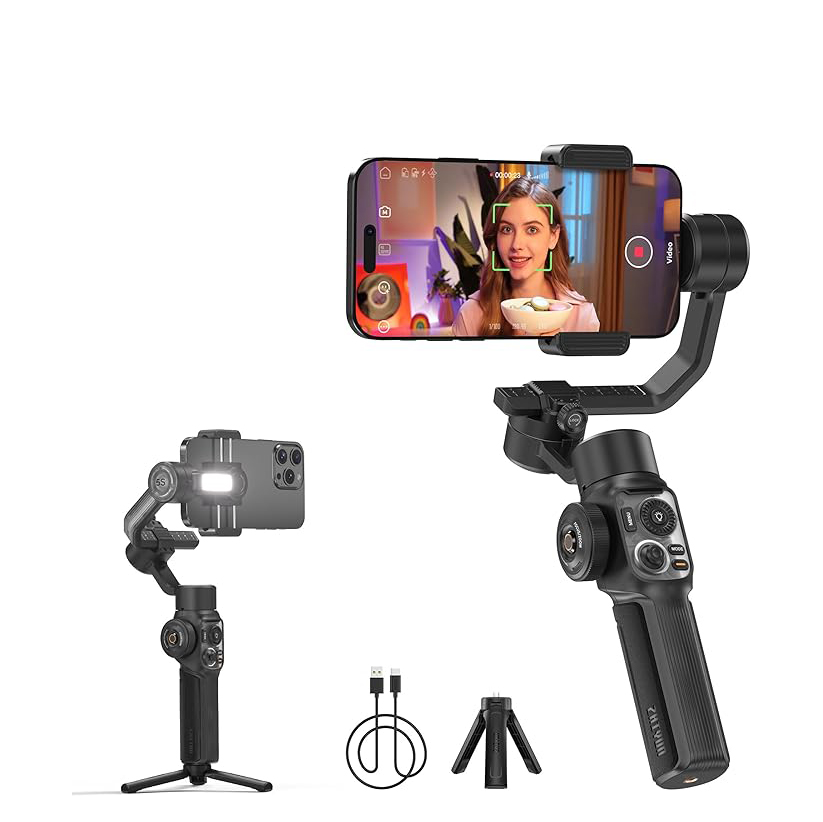
The AI tracker provides the services of a skilled camera operator. The various shooting modes enable you to shoot cinematic camera moves such as crane and tracking shots.
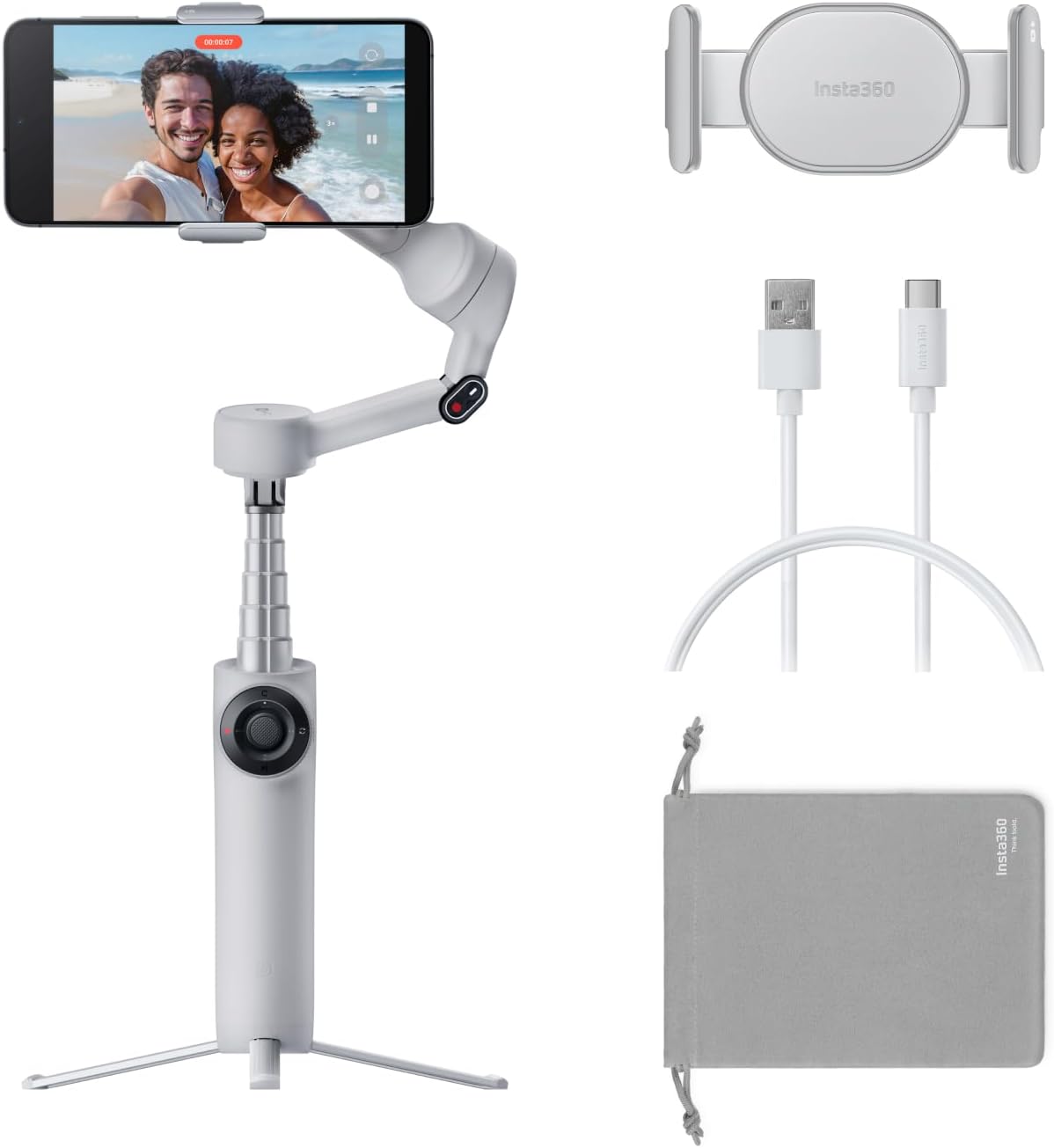
Simple to set up and operate, this smartphone gimbal is the ideal choice for beginners and holidaymakers who don't want anything too complex. It also has its own built-in tripod for group selfies.
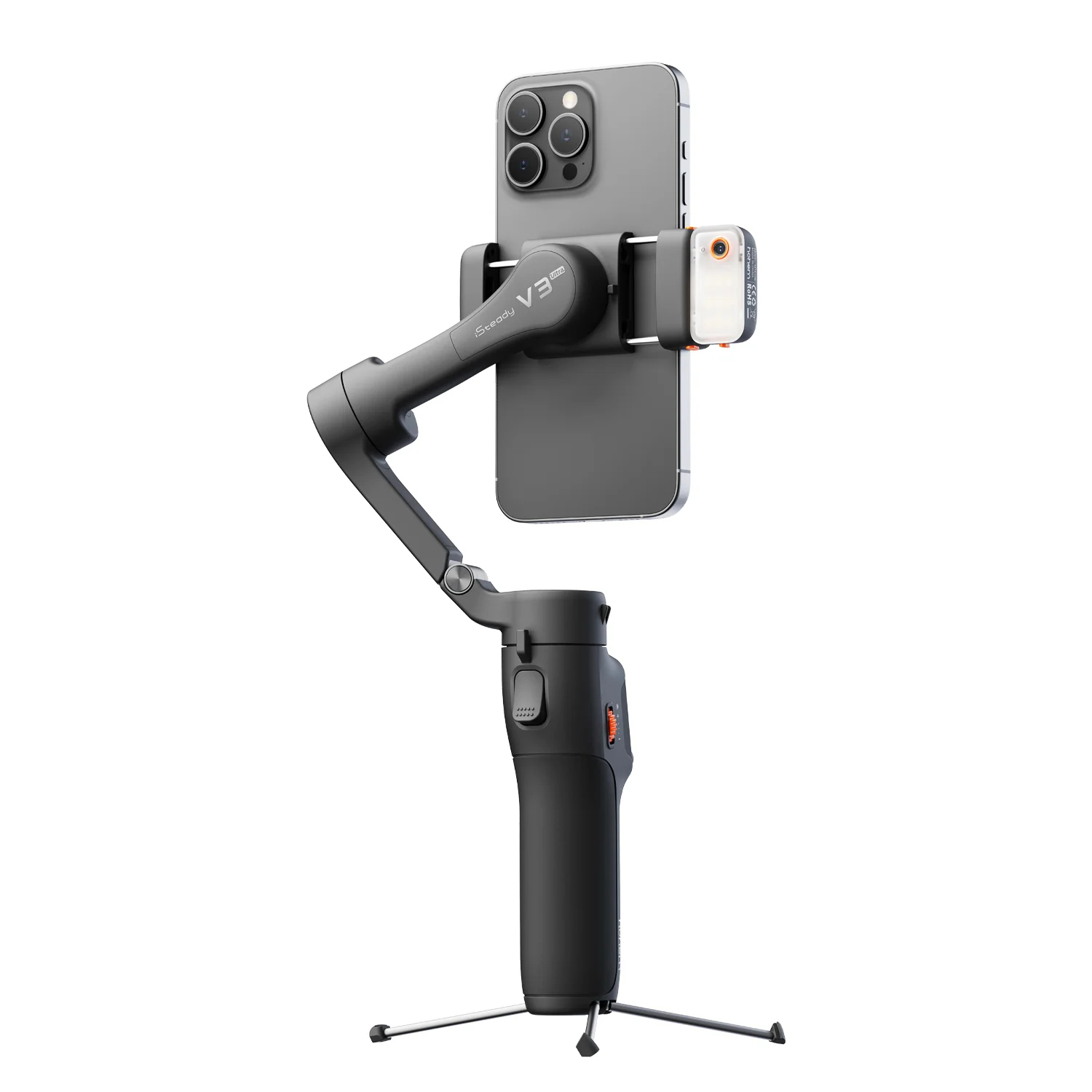
This portable, lightweight 3-axis gimbal is designed to be easy to use and set up, and also benefits from a remote with screen that allows you to see yourself while recording.
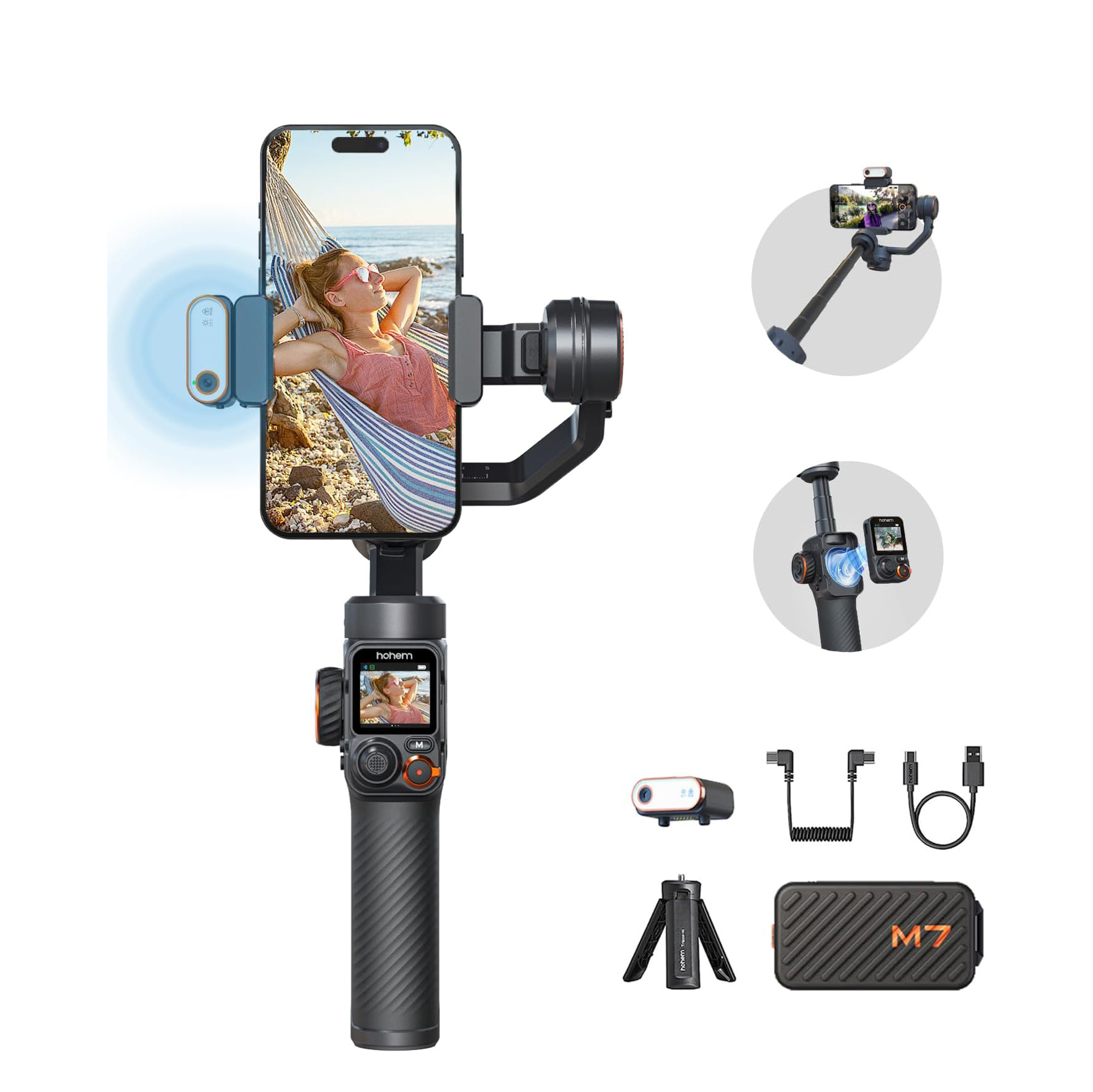
Is money no object? Then check out the Hohem iSteady M7. While it's expensive, you can do a lot with it. This high-quality, 3-axis gimbal can be used with smartphones, has a built in screen and AI tracking!
Best smartphone gimbals: the full guide
Why you can trust Digital Camera World
Best smartphone gimbal overall
Specifications
Reasons to buy
Reasons to avoid
The DJI Osmo Mobile 7P is an extremely robust, professional selfie stick/gimbal that has a lot of advanced features such as motion timelapse, subject tracking, and an analog zoom/focus wheel for easy control. This certainly isn't a budget option but it's by far one of the best selfie sticks you can buy if stabilization is your main game.
Our reviewer tested it using the iPhone 16 Pro Max and despite it being one of the heavier smartphones now available, the gimbal was able to keep up with some aggressive movements and still maintain incredibly smooth footage. He could comfortably get the gimbal to nearly 180˚ without the default mode losing the horizon.
The option of an FPV mode, in which the camera effectively leans into the movement, is a great touch for action footage, and auto-stitched panoramas are also available. Overall, this is an excellent selfie stick/gimbal, but you will have to pay a hefty chunk more.
Read our full DJI Osmo Mobile 7P review for more details
Best smartphone gimbal for tracking

Specifications
Reasons to buy
Reasons to avoid
The Insta360 Flow 2 Pro is a compact and portable smartphone gimbal packed with features to enhance mobile videography. Featuring a lightweight, foldable plastic body for easy transport. The magnetic spring clamp ensures a quick and secure attachment of your iPhone, making setup effortless.
One of its standout features is the built-in tripod integrated directly into the gimbal’s shaft. Unlike other models with separate or flimsy tripod attachments, the Flow 2 Pro offers a sturdy and stable base simply by extending its legs. This design makes it more convenient for stationary shots, time-lapses, or hands-free filming.
A major advantage is its ability to pan continuously through 360 degrees, allowing for seamless subject tracking without limitations. This feature is especially useful for dynamic shots where movement is key. The Insta360 also offers access to Apple's Dockkit tech, which enables intelligent tracking – following your subject by locking focus and keeping them in the center of the frame – very clever stuff.
If you're looking for a gimbal that balances portability, functionality, and stability, this one is a solid choice – although it is a little more expensive than rival products.
Read our full Insta360 Flow 2 Pro review for more details
Best iPhone gimbal for presenting to camera
Specifications
Reasons to buy
Reasons to avoid
The Zhiyun Smooth 5S AI is very comparable to the Hohem iSteady M6 that features in this guide in relation to functions and price, though if you shop around you should be able to get the Hohem at a lower price as the Zhiyun Smooth 5S AI is a newer release.
Like the Hohem iSteady M6, the Zhiyun Smooth 5S AI ships with a magnetic sensor that clips on top of the gimbal just above your smartphone. The sensor uses AI to recognize gestures that trigger a range of actions. For example, if you make the OK gesture then the gimbal will pan and tilt the attached smartphone to keep your face in the frame as you walk and talk. This makes it a valuable tool for a vlogger or presenter who wants to add some movements as they talk to the camera (without having to pay for a camera operator).
Both the iSteady and the Hohem have a mini LED fill light, though the Zhiyun’s LED has the edge when it comes to brightness levels. The AI sensor can be used when running your smartphone’s native Camera app, but it provides extra gesture control when filming via the Zy Cami app as you can start and stop the smartphone recording with a gesture (rather than having to manually tap the record icon).
Read our full Zhiyun Smooth 5S AI review for more details
Best smartphone gimbal for beginners

Specifications
Reasons to buy
Reasons to avoid
If you're looking for a gimbal more to improve your holiday videos and have fun with friends, as opposed to becoming a Serious Content Creator™, then the Insta360 Flow 2 is your best bet. It's an entry-level stabilizer for smartphones, with an emphasis placed on ease of use, portability and affordability. But it still delivers the goods in terms of its stabilization, and is a great choice for travel.
A smaller cousin to the Insta360 Flow 2 Pro featured above, this gimbal is slim and easy to use. As it supports NFC One-Tap Pairing, you can get up and running with the Insta260 app right away, though it'll also work with the native iOS Camera App if you prefer. You don't really need to spend any time balancing it the way you do with more complex camera gimbals
Equipped with AI smarts, the Flow 2 can track human subjects through the frame and pan to follow them, and can also emulate classic camera moves like tilt, pan, crane and dolly. Gesture control allows you to trigger different modes without needing to be physically proximate, and there's also a built-in tripod that means the gimbal can be set up to stand independently – perfect for holiday group shots!
There are some compromises when compared to the flagship Flow 2 Pro. The Flow 2 has more restricted pan and tilt angles, meaning it can't follow a subject around a full 360°. However, it produces solid stabilized footage for a very reasonable price, and is probably the better entry-level buy for those who want something straightforward and easy to operate.
Read our full Insta360 Flow 2 review for more detail
Best smartphone gimbal for traveling light
Specifications
Reasons to buy
Reasons to avoid
The Hohem iSteady V3 Ultra isn't just one of the cheapest and lightest gimbals on this list, but also has plenty of other tricks up its sleeve as well.
A slight upgrade on the previous iSteady V3, the iSteady V3 Ultra adds just 8g to the weight of the previous model, but brings in a host of new features. It can pan freely the full 360° range, meaning that if you've got it tracking yourself or another subject via the intelligent AI system, it'll always be able to keep you in the frame. It also now has a touch-sensitive screen, which also doubles up as a live video feed monitor for the AI tracking system, giving you a means of keeping an eye on your composition while filming yourself.
Of course, the reason filming yourself is possible at all is because the Hohem iSteady V3 Ultra has a self-contained compact tripod design. Slide its three legs out of their storage compartment in the handle, and you've got yourself an independent, free-standing platform to hold your phone while you record. The legs are a little spindly, so you might see a little sway, but it's still hugely useful for solo content creators.
In use, the Hohem iSteady V3 Ultra is smooth and impressive, as George discovered in our full review. The AI tracking is reliable and consistent, and the gesture-based controls mean you can switch tracking modes on the fly without needing to trudge back over to your setup and fiddle with buttons. The real game-changer though is that front-facing video feed, which just makes it so much easier to capture content when you're by yourself.
Affordable and light on its feet, the Hohem iSteady V3 Ultra is an ideal starter gimbal for smartphone shooters, especially those who are going to be shooting their content independently.
Read our full Hohem iSteady V3 Ultra review for more details
Best premium smartphone gimbal
Specifications
Reasons to buy
Reasons to avoid
One challenge we face when using a stabiliser is whether to use the smartphone’s front or rear cameras. If you use the front camera, you can see your footage on the smartphone’s screen and know exactly where you are in the frame. However, the front camera tends to be more limited and of lower quality than the rear cameras, but if you use the rear camera, then you won’t be able to see your footage as it's being recorded. The Insta360 Flow 2 featured elsewhere in this buying guide solves this problem by having a mirror on the rear of the gimbal, which gives you an idea of where your face is positioned when shooting a selfie ‘blind’. The more expensive Hohem iSteady V7 offers a more effective solution by feeding live video footage from the AI-sensor at the front of the gimbal to the touchscreen display at the rear.
The Hohem iSteady M7’s AI-tracker enables you to rest the gimbal on its mini tripod, extend the selfie stick (or extension pole), and then it will follow your every move as you walk and talk freely. You can also operate it remotely by detaching the touchscreen panel and using the mini joystick to pan and tilt the camera. When holding the M7 in your hand, it’s an easy operation to tap the physical Mode button to make the gimbal perform classic Pan, Pan Follow, and POV (Point of View) moves as well as craning the camera from a low to high angle for a cinematic look. Check out our full review to see a video of the M7 as it makes some Hollywood style moves with it.
Every rose has its thorns, and in the case of the Hohem iSteady M7, we could occasionally glimpse a bit of the roll motor at the far right of the frame when making a steep tilting move. This didn’t cause problems for most of our camera moves, but it means the gimbal isn’t perfect, so it didn’t quite hit the 5-star rating that its innovative live front-to-rear camera feed would have earned it.
Read our full Hohem iSteady M7 review for more details
How to choose the best smartphone gimbal
When looking for the best smartphone gimbal features, there are several important factors to consider. First, it's crucial to check the phone size specifications to ensure your device will fit the gimbal. Many of today's best camera phones are quite large, so this compatibility is essential. Another desirable feature is the ability to quickly rotate between horizontal and vertical shooting orientations, which can be especially useful for capturing content for platforms like TikTok.
Selfie sticks integrated into the gimbal design can also be a convenient addition, allowing you to hold the device further away to film yourself effectively. Additionally, the folded size of the gimbal is worth considering, as the most compact models can fit easily into a bag or coat pocket, making them highly portable. Finally, some gimbals come equipped with built-in or magnetically attached LED lights, which can be surprisingly powerful and effective for illuminating selfie shots.
What is a smartphone gimbal?
A smartphone gimbal is a motorized device that uses motors and sensors to counteract shake and keep your smartphone camera steady. This allows you to shoot smooth, professional-looking videos with your phone.
How do smartphone gimbals work?
Smartphone gimbals use brushless motors to constantly adjust the position of your phone, keeping it level and stable even when you move. They detect unwanted movements and counteract them, resulting in smooth footage.
What are the benefits of using a smartphone gimbal?
The main benefit of using a smartphone gimbal is the silky-smooth, stabilized video it produces. By eliminating shaky footage, your videos will take on a professional polish. Gimbals also benefit low-light shooting. Since the gimbal keeps your phone perfectly steady, you can use slower shutter speeds to capture more light without worrying about blurry videos. On top of these core benefits, many smartphone gimbals boast features like pan follows and object tracking that open up a world of creative camera movements for you to explore.
How we test smartphone gimbals
Our expert reviewers put smartphone gimbals through a rigorous testing process to assess their real-world performance and capabilities. First, they carefully balance the gimbals to ensure optimal weight distribution and smooth operation. They then test the various shooting modes, evaluating how well the gimbal is able to stabilize the phone during different types of movement and camera angles.
The accessibility and intuitiveness of the controls are also closely examined, as is the quality of any companion apps. Our testers assess features like the fill light, zoom/focus mechanisms, and tracking algorithms to see how they enhance the filming experience. Durability is tested too, by seeing how the gimbal handles being transported and used in different environments. Finally, the overall value proposition is considered: do the features and performance justify the price point?
Compare prices
The best camera deals, reviews, product advice, and unmissable photography news, direct to your inbox!

Gareth is a photographer based in London, working as a freelance photographer and videographer for the past several years, having the privilege to shoot for some household names. With work focusing on fashion, portrait and lifestyle content creation, he has developed a range of skills covering everything from editorial shoots to social media videos. Outside of work, he has a personal passion for travel and nature photography, with a devotion to sustainability and environmental causes.
